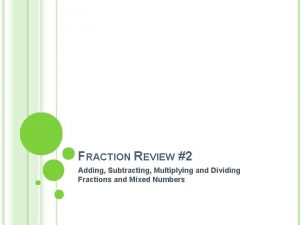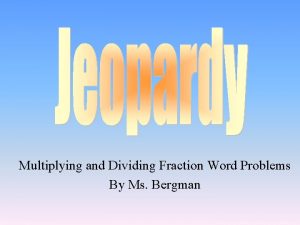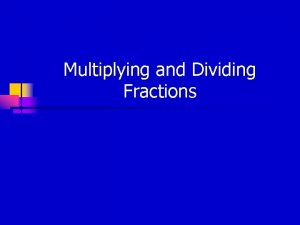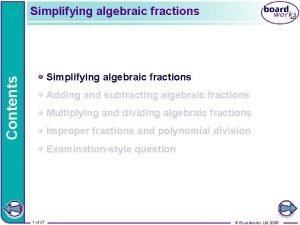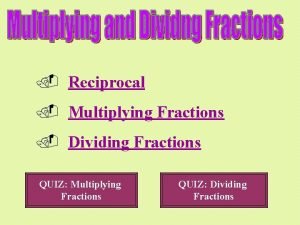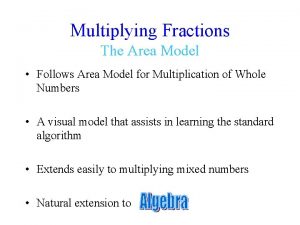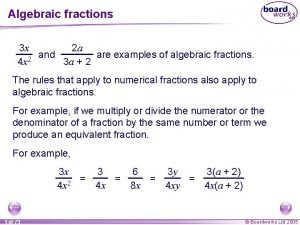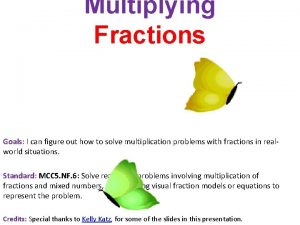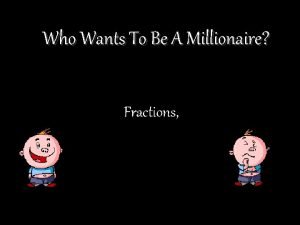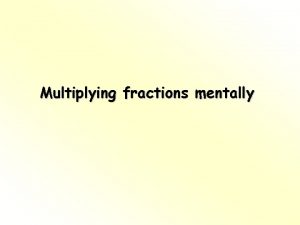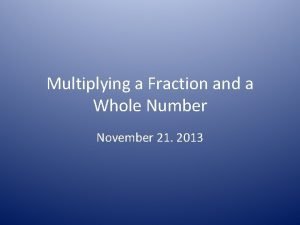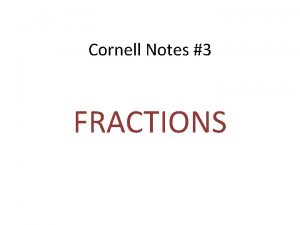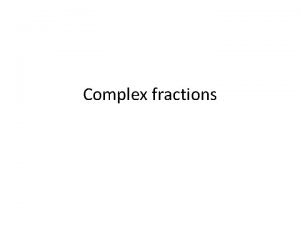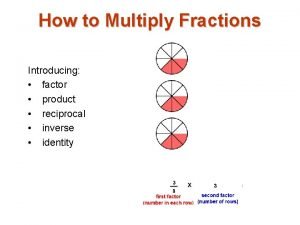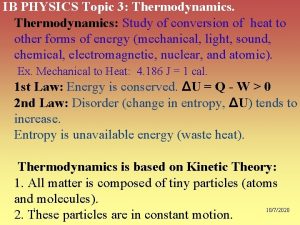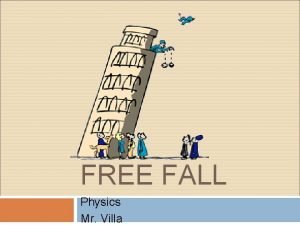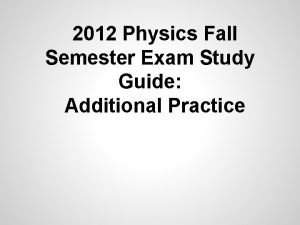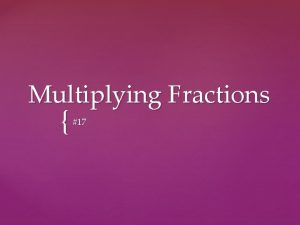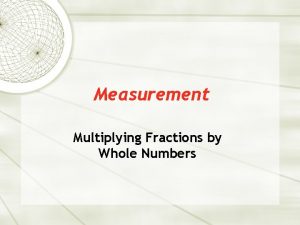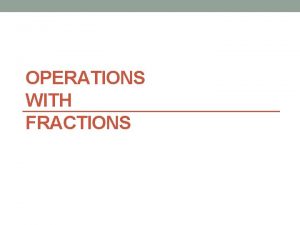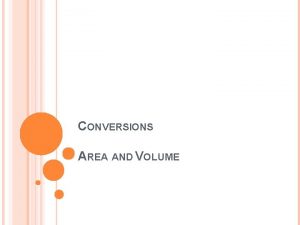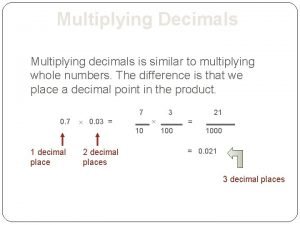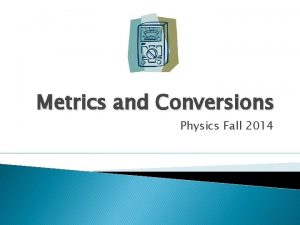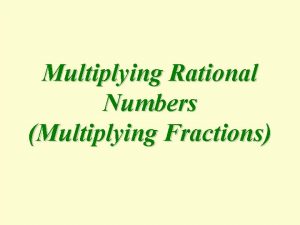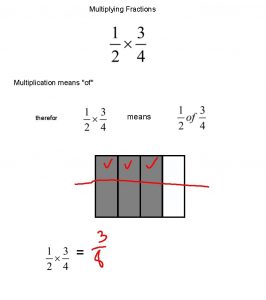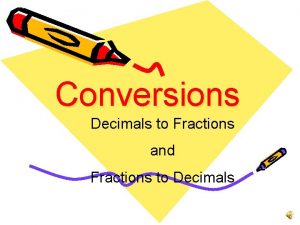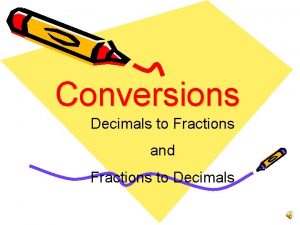Metrics and Conversions Physics Fall 2015 Multiplying fractions






















- Slides: 22

Metrics and Conversions Physics Fall 2015

Multiplying fractions review � When given a problem like this: 2 1 x 2 = __ 5 3 15 how do you solve it? � You multiply straight across! � Do this one on your notes: 9 3 x 3 = __ 8 2 4

Cancel out if possible � What about if you are given this problem: 6 3 x 2 = __ 4 3 12 � You could multiply straight across and then simplify… � or you could cancel out first to make the problem easier 2 3 x 2 = __ 4 3 4

Conversions � Turn to your neighbor and briefly discuss what it means to convert ◦ To convert means to change from one to another ◦ But what are we converting between? �Usually from one unit to another �A unit is a word or abbreviation that comes after the number and describes what that number means �Turn to a new neighbor and briefly discuss why you think it is important to include units with numbers 100 Vs 100 dollars vs 100 cents vs 100 miles

Conversions cont’d � How many shoes do you have if you have 6 pairs of shoes? ◦ How did you figure out that you would have 12 shoes? � How many roses do you have if you are given 4 dozen roses? ◦ How did you figure out that there would be 48 roses? � The fact that there are 2 shoes in a pair of shoes or 12 roses in a dozen roses represent a conversion factor ◦ fractions in which the numerator is equal to the denominator, but the units are different 2 shoes 12 roses 1 pair shoes 1 dozen roses Discuss with a neighbor some other conversion factors you know of

Convert this � Use a conversion factor to convert 3 hours into minutes: 1. What is the conversion factor? �There are 60 minutes in an hour so: 1 hr or 60 min I hr 2. Set up the problem 60 min = ______ 180 min 3 hr x ______ 1 hr 1 *** remember, you want to cancel hours and be left with minutes, so which of the two conversion factors will you use?

Convert this: � Use a conversion factor to convert 360 minutes into hours: 1. What is the conversion factor? 60 min 1 hr 2. Set up the problem 1 hr = ______ 360 = 6 hrs 360 min x ______ 1 60 min 60

Convert this: � Use a conversion factor to convert 96 inches into feet: 96 in x 1 ft = 96 = 8 ft 1 12 in 12

2 step conversions � Convert 3 yards into inches 3 yrds x 36 in = 108 inches 1 1 yrd

What does this have to do with science? � METRICS!!!! ◦ Turn to a neighbor and discuss what you remember/know about metrics ◦ Used for different scientific measurements ◦ Based on the number “ 10” ◦ Base units: �Mass – gram �Volume – liter �Distance (length) - meter

Metric terms � Prefixes are words or parts of words that come “before” another word or word part � Metric prefixes: ◦ ◦ ◦ ◦ Kilo (K) = 1000 m Hecto (H) = 100 m Deca (D) = 10 m Base unit = 1 m deci (d) = 1/10 m centi (c) = 1/100 m milli (m) = 1/1000 m � To help you remember the prefixes in order: King Henry Died by Drinking Chocolate Milk

Conversion factors for metrics � Up to this point, you have probably converted between the metric prefixes by simply moving the decimal, right? ◦ Not anymore! ◦ Now, you must use/show the correct conversion factors when converting between the various prefixes – this is called dimensional analysis ◦ Conversion factors examples: 1 Km or 1000 m cm or m m Km m cm 1000 mm or 1 m m cm

Let’s convert! � Convert 3. 5 m to cm 1. What is the correct conversion factor? ** Which conversion factor will 1 m or 100 cm allow you to correctly cancel your 100 cm 1 m starting units and leave you with the correct ending units? ** 2. Solve the problem 350 3. 5 m x 100 cm = ____ cm 1 1 m

We’ll work one together � Covert 2. 56 mm to m 1. What is the correct conversion factor? 1000 mm 1 m 2. Set up the problem and solve 2. 56 mm x 1 m = 2. 56 = 0. 00256 m 1 1000 mm 1000

Your turn! � Convert 3. 4 Km to m 3. 4 Km x 1000 m = 3400 m 1 1 Km

A bit more difficult � Convert 1. 25 Km to cm � Can you go directly from Km to cm? ◦ No, you have to do this in two steps so you need two conversion factors 1. 1 Km or 1000 m ** Which conversion factor will 1000 m 1 Km allow you to correctly cancel your 2. 1 m or 100 cm starting units and leave you with the correct ending units? ** 100 cm 1 m � Solve the problem 1. 25 Km x 1000 m x 100 cm = 125000 cm 1 1 Km Im

Work it together � Covert 3. 2 mm to Km 1. What is the correct conversion factor? 1000 mm and 1000 m 1 Km 2. Set up the problem and solve 3. 2 mm x 1 Km = 0. 0000032 Km 1 1000 mm I 000 m

On your own � Convert 9 Km to cm 9 Km x 1000 m x 100 cm = 900000 cm 1 1 Km 1

Now go back to your measuring activity and complete third column by converting the measurements to the given unit!

This is too easy…. � So let’s make it a bit harder ◦ Can you convert 8 km/hr into m/s? ◦ Of course you can – this is called a double conversion �Where you are converting two different units in the same problem �The key to solving these is to convert the units separately 8 Km x 1000 m x 1 hr x 1 Km 60 min 1 hr 1 min = 2. 2222 m/s 60 s

Let’s do another one together � Convert 575 Km/hr to cm/min 575 Km x 1 hr 1000 m 1 Km x 100 cm x 1 m 1 hr 60 min 958333. 333 cm/min =

One more for good measure � Convert 2500 cm/sec m/min
 Multiplying and dividing fractions and decimals
Multiplying and dividing fractions and decimals Adding subtracting multiplying and dividing fractions
Adding subtracting multiplying and dividing fractions Multiplying and dividing fractions word problems
Multiplying and dividing fractions word problems Multiplying and dividing fractions lesson
Multiplying and dividing fractions lesson Complex algebraic fractions
Complex algebraic fractions Adding subtracting multiplying and dividing fractions quiz
Adding subtracting multiplying and dividing fractions quiz Area model multiplication fractions
Area model multiplication fractions How to multiply mixed fractions
How to multiply mixed fractions Dividing algebraic fractions
Dividing algebraic fractions Butterfly method multiplication
Butterfly method multiplication Multiplying fractions jeopardy
Multiplying fractions jeopardy Multiplying fractions vocabulary
Multiplying fractions vocabulary Fraction millionaire
Fraction millionaire How to multiply fractions mentally
How to multiply fractions mentally Multiplying fractions by whole numbers examples
Multiplying fractions by whole numbers examples Notes on adding and subtracting fractions
Notes on adding and subtracting fractions Fraction rules
Fraction rules Equivalent fraction bingo
Equivalent fraction bingo Multiplying fractions jeopardy
Multiplying fractions jeopardy Ib physics conversions
Ib physics conversions Free fall
Free fall Physics fall final exam review
Physics fall final exam review Physics fall semester review answers
Physics fall semester review answers

